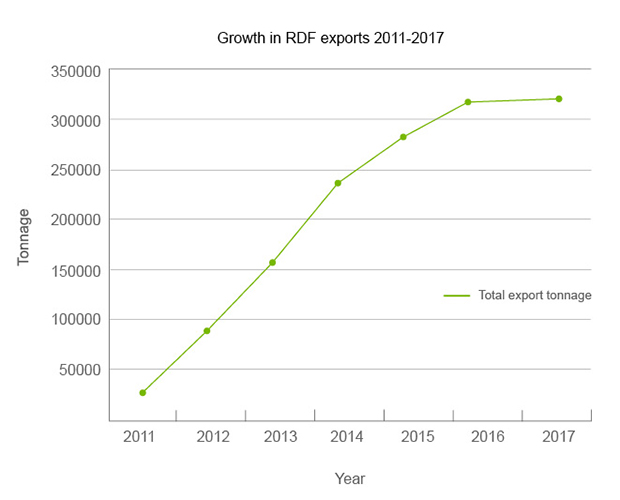The amount of refuse derived fuel exported from England appears to have plateaued, according to provisional figures published by the Environment Agency for 2017.
According to data released for January to December 2017, around 3,200,788 tonnes of waste derived fuel was approved for export. This compares to around 3,194,426 the previous year.
The feedstock material predominantly consists of RDF, however there is a growing amount of solid recovered fuel (SRF) being sent to the continent for incineration. In total, almost 186,191 tonnes of SRF was exported compared to 42,340 tonnes in 2016.
The Agency figures for 2016 also include the shipment of other materials, including non ferrous metal concentrate. However, with the addition of these materials the total waste exported is marginally above the 2017 rate at 3,2129,70.
Capacity
The provisional figures further support the view that RDF exports from England are continuing to level out, as more opportunities arise on the domestic market and energy from waste facilities in European countries reach their capacity.
In 2014, exports of waste derived fuels shot up to 2.37 million tonnes – more than 750,000 tonnes greater than the amount exported in 2013.
But, in 2015 the gap began to close, with exports rising by an estimated 450,000 tonnes on the previous year, to 2.82 million tonnes.
The recently published figures for 2017 are just under 6,362 tonnes above the level exported during 2016.
Country
The Netherlands continued to be the largest recipient of waste derived fuels with around 1,539,720 million tonnes received. The country retained its large margin in terms of imports receiving almost half off all material shipped out.
However, again, exports to the Netherlands appear to be levelling out after increasing by only 12,589 tonnes from 2016.
Germany and Sweden both remained significant markets for RDF from England, with Germany receiving 641,218 tonnes and Sweden 528,734 tonnes. Other countries to receive smaller amounts of RDF included Norway (135,559), Latvia (80,550), Denmark (77,658) and Cyprus (48,757). Belgium, Bulgaria, France, Poland and Spain also received the material.
Company
In terms of companies, Biffa remained the largest exporter with around 460,383 tonnes of waste derived fuel shipped to the continent. The company was followed by Suez at 405,120 tonnes and N&P Alternative Fuels at 316,924 tonnes. Other companies to export large amounts of RDF included Geminor UK (282,164), Seneca Environmental Solutions (218,945), Andusia (183,965), FCC (178,259), Veolia (148,611) Shanks (131,346) and New Earth Solutions (103,522).
At the other end of the scale, Taurus Waste Recycling exported the smallest quantity of RDF at just 444 tonnes, followed by Combineering A/S at 2,500 tonnes.
Companies including Bertling Enviro (87,066), Probio Energy (82,551) and Countrystyle Recycling (78,899) exported quantities of RDF below 100,000 tonnes.
The post RDF exports plateau in 2017 appeared first on letsrecycle.com.
Source: letsrecycle.com Waste Managment




